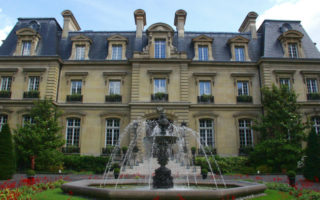A Case of the Blues: The French Flag Shows its True Colors
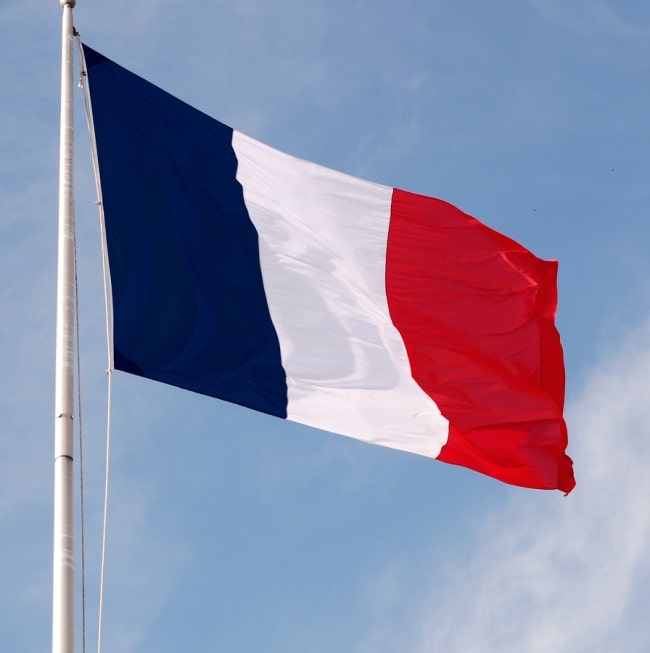
- SUBSCRIBE
- ALREADY SUBSCRIBED?
BECOME A BONJOUR PARIS MEMBER
Gain full access to our collection of over 5,000 articles and bring the City of Light into your life. Just 60 USD per year.
Find out why you should become a member here.
Sign in
Fill in your credentials below.
Flying above the Elysée Palace, France’s tricolore of blue, white and red now features a darker navy blue — truer to the historical version of the flag than the much brighter blue that’s been raised on the nation’s flagpoles since 1976.
The little-noted alteration of France’s national emblem occurred on July 13, 2020, when flags boasting the new color were hoisted at the official headquarters of the president of France. With no accompanying fanfare, the alteration was so slight that most citizens didn’t even notice the difference.
The traditional navy blue stripe had been changed to a lighter hue in 1976 to match the brighter blue of the European Union Flag. Valéry Giscard d’Estaing, president at the time, was a strong supporter of the Union, and he made the decision to avoid the two blues clashing when flying on adjacent flagpoles or draped next to each other on official podiums.
Now the flag placed behind President Macron at conferences and speeches will feature the classic navy blue. Emmanuel Macron’s office darkened the blue on the official French flag to bring the tricolore in line with how it looked after the French Revolution. The president’s office announced that the change was meant as a tribute to those who fought in the French Revolution, and the two World Wars.

President Emmanuel Macron. © Wikimedia commons
Prior to the 1976 change, France had been flying the navy blue, white, and red flag since the end of the 18th century. The flag we know today evolved out of the French Revolution and the current design — blue next to the flagpole, white and then red — was formally adopted on February 15th 1794.
Before the French Revolution, the monarchy used many flags. The standard most commonly flown before the uprising consisted of a blue shield flanked by winged angels hovering overtop of a grid of gold fleur-de-lis on a white background. It was fussy and hard to reproduce.
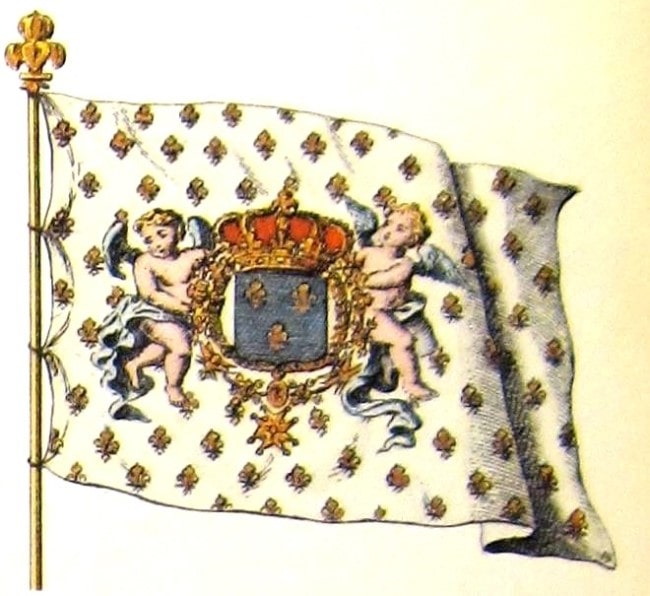
Royal Standard of the Kingdom of France. Wikipedia commons
The change to blue and red came from the cockades — the cloth rosettes — worn by the revolutionaries who stormed the Bastille in 1789. The ancient colors of the city of Paris were blue and red. The Commander of the Guard, Marquis de Lafayette, it appears, added the Bourbon white.
The colors of these cockades were the basis for the flag design adopted in 1790, which at that time featured red next to the flagpole. This simplified design illustrated in broad strokes how France had broken with the past.

Sans-culotte (left), compared with figures wearing culottes (right). Public domain.
On February 15, 1794, the tricolore was established as France’s national flag. Along with Lafayette, the important painter, Jacques-Louis David is credited with its design. David, the painter of the Death of Marat (1793), and the Coronation of Napoleon (1805-07), was also a member of the revolutionary parliament. At his recommendation, it was decreed that the blue should be flown nearest the flagpole.
However, as post-Revolutionary France wavered complicatedly between a republic, a monarchy, and a dictatorship, the French tricolore has not had smooth sailing. The tricolore was removed from circulation several times because it was too closely associated with the Revolution of 1789.
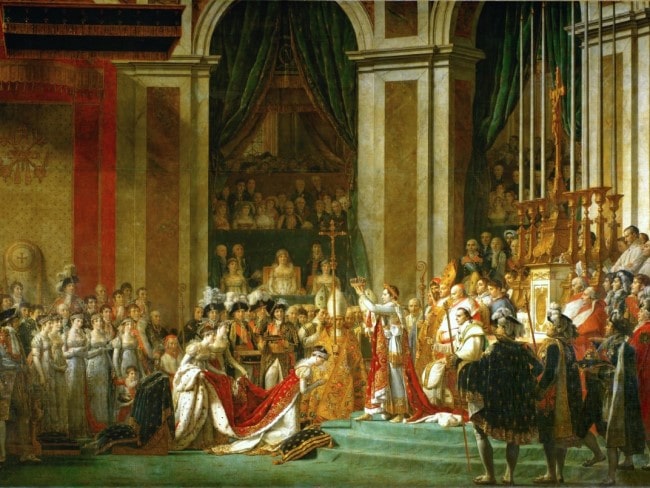
Jacques-Louis David, “The Coronation of Napoleon,” (1805-1807).
The white royal flag was flown during the Bourbon restoration of from 1815-1830, but the three-colored flag was brought back in the July Revolution of 1830. The change was most famously and fervently depicted in Eugène Delacroix’s Liberty Leading the People, painted in the months following the uprising.
After the First World War, the colors of the flag were thought to aptly memorialize the French soldiers who had died serving their country. New recruits in their blue trousers were called cornflowers or bleuets; the red represented the poppy or coquelicot, that grew freely in the fields where soldiers had been mown down. With the addition of the white marguerite, it was said sentimentally that it was if the dead soldiers laid beneath a floral tricolore of France. The colors of the French flag may also represent the three main estates of the Ancien Régime: the clergy, the monarchy, and the bourgeoisie. However, the website of French Ministry of Foreign affairs confirms that the display consists of the colors of the King – white, and those of the City of Paris – blue and red.
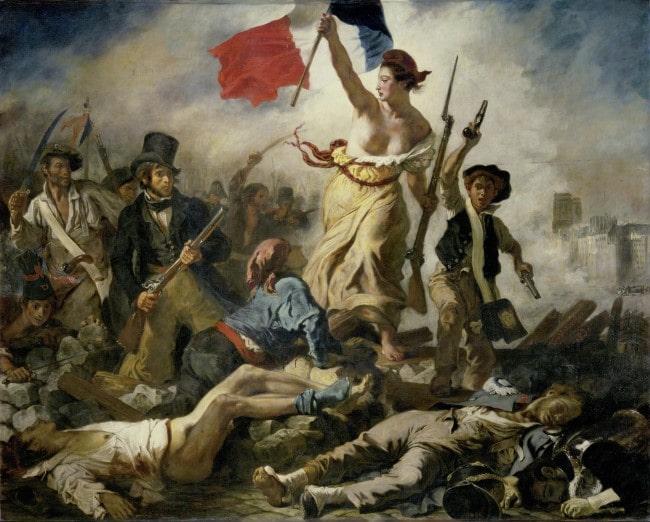
Eugène Delacroix, “Liberty Leading the People,” (1830). Louvre Museum
Today the blue, white and red flag is the national emblem of the French Republic and is protected by the nation’s constitution. Macron at this time has given no firm instruction to other French institutions i.e. town halls and schools, to update their flags. It appears a mixture of both the darker and lighter flags have been in use for decades. France’s National Navy and many official buildings around the country have always used the bleu-marine. An Elysée official pointed out that the flag on the Arc de Triomphe in Paris had always featured the darker hue.
There was reportedly some disagreement over Macron’s change back to navy blue, with some arguing the new shade was ugly and would clash with the EU flag, while others considered the deep blue an elegant connection with the nation’s history. Some thought the change in colors signaled a rift between France and the European Union.
Whatever the symbolism, the French flag represents liberty, equality and fraternity worldwide.
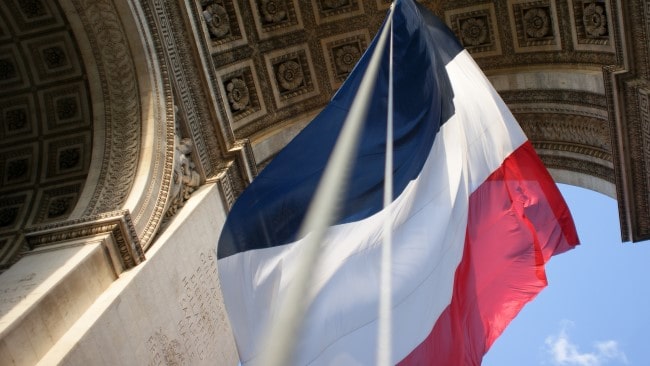
Flag of France at the Arc de Triomphe. Photo credit: CherryX / Wikimedia commons.
Lead photo credit : Drapeau de la France. Wikimedia commons
More in flag, French history, history


